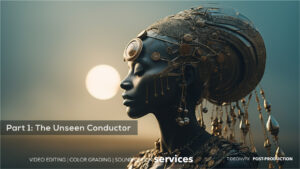Audio
Part 4: Emotional Resonance in Film Editing – The Power of Film Music
Image Courtesy of Blackeyehub.com
Part 4: Emotional Resonance in Film Editing – The Power of Film Music
Introduction
In the realm of filmmaking, the fusion of imagery and sound isn’t just about telling a story; it’s about feeling it. Music in film isn’t just an auditory experience; it’s a vital tool for emotional storytelling. In this fourth instalment of our series, we delve into the profound role of music in enhancing the emotional resonance of a film.
The Emotional Language of Music
Film is an art form that communicates on a deeply emotional level. Music, with its unique ability to evoke feelings, becomes an indispensable part of this communication. It acts as a bridge between the visual story and the audience’s emotional response, creating a more immersive and emotive experience.
Sculpting Emotions in Editing
During post-production, editors are tasked with a crucial role: to shape the film’s emotional landscape. This involves more than just aligning music with the narrative; it’s about choosing tracks that reflect and enhance the emotional undertones of each scene.
- Understanding Emotional Beats: Editors must identify key emotional moments in the film – a character’s revelation, a turning point in the story, a moment of conflict – and use music to heighten these moments.
- Subtlety and Nuance: The power of music lies in its subtlety. A gentle piano piece might underscore a character’s internal struggle, while an orchestral crescendo could signify a triumphant conclusion.
Music as a Conduit for Emotion
Music has the profound ability to express what cannot be said with words or shown with images. It conveys the unspoken, touching the audience’s hearts and drawing them deeper into the story.
- Transcending Visuals: In scenes where dialogue and visuals take a backseat, music comes to the forefront, carrying the emotional weight of the moment.
- Creating Empathy: Music guides the audience’s emotional journey, allowing them to connect with characters and understand their experiences on a more intimate level.
Case Studies: Emotional Resonance in Action
To illustrate this concept, let’s look at some iconic film moments:
- The Stirring Score of ‘Schindler’s List’: John Williams’ haunting violin compositions amplify the emotional gravity of the film, making the audience feel the profound sadness and hope.
- The Triumphant Symphony in ‘The Shawshank Redemption’: As Andy Dufresne stands in the rain, finally free from the confines of prison, the powerful music crescendo sets a tone of liberation and triumph. This scene is a masterful example of how music can amplify a pivotal moment, transforming it into an unforgettable cinematic experience. The soaring score encapsulates Andy’s journey and emotional release, making this scene one of the most memorable in film history.

Music Sets The Tone
As Andy Dufresne stands liberated in the pouring rain, the crescendo of the powerful score encapsulates a moment of triumph, beautifully accentuating his escape from the confines of prison.
By aligning the emotional beats of the narrative with the right musical choices, filmmakers can create moments that resonate deeply with audiences, demonstrating the profound impact music has in the art of storytelling.
Conclusion
In conclusion, music in film is much more than an auditory accompaniment; it’s a critical tool for emotional storytelling. As editors, we hold the responsibility of not just assembling a sequence of shots but weaving an emotional tapestry that resonates with the audience. Understanding the emotional beats of a film and choosing the right music to amplify them is what transforms a good film into a great one, leaving a lasting impact on its viewers.










